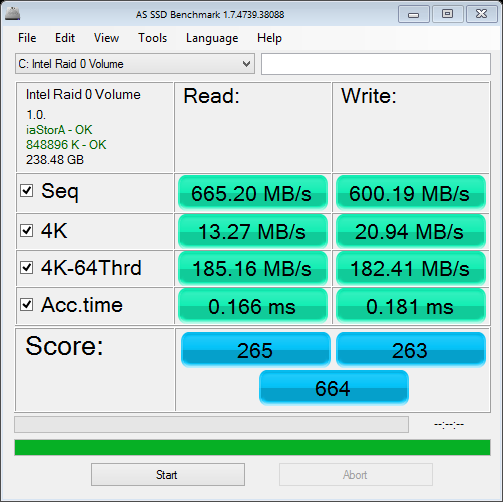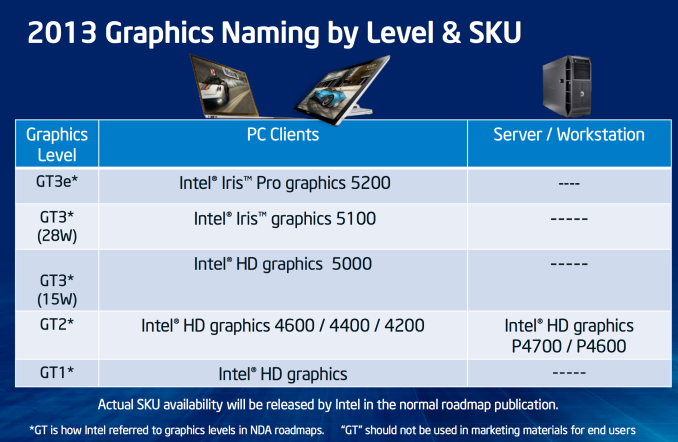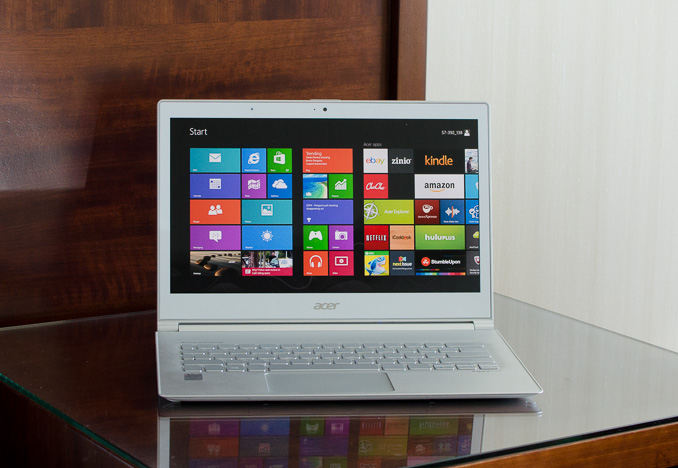The Haswell Ultrabook Review: Core i7-4500U Tested
by Anand Lal Shimpi on June 9, 2013 9:00 AM ESTHaswell ULT Graphics
As I mentioned in our Iris Pro review, Intel’s 128MB eDRAM die (codename Crystalwell) isn’t available on any dual-core parts, excluding it from Haswell ULT. Intel will offer both GT2 and GT3 GPU (20EU/40EU) implementations however. With max GPU clocks below 1100MHz, these parts are devoid of Iris Pro branding and are instead referred to as Intel HD Graphics.
The Test System and Haswell ULT SKUs
Before Computex, Acer announced the 2nd generation Aspire S7 based on Haswell ULT. I managed to get my hands on an early version of the new S7 and that will serve as the platform for the performance and battery life comparisons going forward.
I’ll do a separate piece, likely post-Computex, on the new S7 but I did want to share some preliminary thoughts about the machine here. The 2nd generation S7 looks a lot like the Ivy Bridge model. The chassis retains the Gorilla Glass covered display backing, aluminum base and capacitive touch screen. The Aspire S7 is still a beautiful notebook and shows huge progress from where Acer was just a few years ago. Despite the similarities, the 2nd generation Aspire S7 does come with some much needed tweaks and enhancements.
Acer started with the backlit keyboard, and increased key travel almost to the point of the MacBook Air. I didn’t have a ton of experience with the previous generation model, but this one feels a millimeter or so short of the travel on the MacBook Pro with Retina Display. Unfortunately there’s still no function lock, which means that things like Alt+F4 are still three-key combinations. The clickpad is powered by Elan, although I’ve heard murmurings of Acer switching to Synaptics going forward. Synaptics remains the closest to providing an Apple-like solution for clickpad performance, although even its solutions still need a little more work. Ergonomically the S7’s clickpad is recessed into the chassis just slightly more than I’d like.
The display was the target of major attention as well. By default the new Aspire S7 comes with a 13.3-inch 1920 x 1080 panel, however some models will offer an optional 2560 x 1440 panel instead. Unfortunately my sample only had the 1080p panel, but I’ve seen the 1440p version up close and it’s very impressive. I’m glad to see more PC notebook vendors not only go beyond 1366 x 768, but also exceed 1080p. Now all we need is for Microsoft to do a better job of handling high-DPI monitors in desktop mode.
Internally, my sample has a Core i7-4500U. The 4500U is the spiritual successor to the Core i7-3517U from our 1st generation Aspire S7 review unit. A look at the high level specs points to only a 100MHz reduction in base frequency, but identical max turbo frequencies. On the GPU side, there’s an increase in the number of EUs but relatively similar max operating frequencies. Based on the EU and clock differences, the max increase in graphics performance should be limited to around 19.5% (assuming both Haswell and Ivy Bridge are capable of hitting the same GPU turbo frequencies with the same regularity). I’m very eager to get my hands on an Ultrabook based on Intel’s GT3/HD 5000/Iris 5100, however that will have to wait for another day.
| Intel 4th Gen Core i7/i5/i3 Dual-Core U-Series Processors | ||||||||
| Model | Core i7-4650U | Core i7-4550U | Core i7-4500U | Core i5-4350U | Core i5-4250U | Core i5-4200U | Core i3-4100U | Core i3-4000U |
| Cores/Threads | 2/4 | 2/4 | 2/4 | 2/4 | 2/4 | 2/4 | 2/4 | 2/4 |
| CPU Base Freq | 1.7 | 1.5 | 1.8 | 1.4 | 1.3 | 1.6 | 1.8 | 1.7 |
| Max SC Turbo | 3.3 | 3.0 | 3.0 | 2.9 | 2.6 | 2.6 | n/a | n/a |
| Max DC Turbo | 2.9 | 2.7 | 2.7 | 2.6 | 2.3 | 2.3 | n/a | n/a |
| TDP | 15W | 15W | 15W | 15W | 15W | 15W | 15W | 15W |
| HD Graphics | 5000 | 5000 | 4400 | 5000 | 5000 | 4400 | 4400 | 4400 |
| GPU Clock | 200-1100 | 200-1100 | 200-1100 | 200-1100 | 200-1000 | 200-1000 | 200-1000 | 200-1000 |
| L3 Cache | 4MB | 4MB | 4MB | 3MB | 3MB | 3MB | 3MB | 3MB |
| DDR3/DDR3L | 1600 | 1600 | 1600 | 1600 | 1600 | 1600 | 1600 | 1600 |
| vPro/TXT | Yes | No | No | Yes | No | No | No | No |
| VT-d | Yes | Yes | No | Yes | Yes | No | Yes | Yes |
| Intel SBA | Yes | Yes | Yes | Yes | Yes | Yes | ||
Like all 15W Ultrabooks, the Aspire S7 uses a single fan to cool the Haswell CPU. You will hear the fan ramp up, and the bottom of the chassis gets warm, but neither were uncomfortable to me personally.

Acer continues to use an internal RAID-0 of Lite On mSATA SSDs. In this case there are two Marvell 88SS9174 based SSDs in RAID-0. The combination yields a peak sequential throughput of 665MB/s, which is pretty fast for an Ultrabook. Although I’d personally prefer a simpler, non-RAID setup, I can understand why Acer would be tempted to do something like this.
The SSDs in the S7 now support device sleep (DEVSLP), which boasts incredibly low power consumption when the system is asleep. The way it works is pretty neat. Using HIPM and DIPM, SSD controllers can do a good job of powering down big blocks of the controller however the SATA PHY can’t be powered down otherwise you risk losing communication with the drive itself. The device sleep spec calls for an out of band signal telling the SSD when it can go to sleep and when it can wake up. Since the signal is out of band, the SATA PHY doesn’t need to be active for communication, and thus the SATA PHY itself can power down. Lite On tells me that in DEVSLP mode, its SSDs will draw somewhere around 2mW of power - that’s compared to around 100mW when they’re in DIPM slumber. With Haswell, Intel is very focused on driving power outside of the CPU as low as possible - DEVSLP is a very good example of doing just that.
Acer dramatically increased the battery capacity of the Aspire S7 from 35Wh up to 46Wh. Despite the higher capacity battery there’s no increase in weight. The 13.3-inch S7 still weighs around 2.86 lbs.













87 Comments
View All Comments
warezme - Monday, June 10, 2013 - link
"the processor graphics story by finally delivering discrete GPU class gaming performance". I hate this summation being thrown around, as I'm sure it will get re quoted somewhere as gospel. It is definitely NOT discrete GPU class gaming performance in any shape or form. There should be a limit to what is considered discrete GPU performance, like maybe 30-60FPS at, at least 1600x900 resolution and game settings across the board for all games set to Medium. That is not crazy or unreasonable for a true discrete GPU you would actually go out and buy. It shouldn't be unreasonable than to expect that in a built in GPU that is sold as "discrete GPU" quality.gnx - Monday, June 10, 2013 - link
Kudos! You have to love AnandTech for providing such detailed analysis, so soon after Haswell was made public!But it does seem that Haswell for Ultrabooks isn't so revolutionary as Intel seemed to imply. Not that we have much of a choice, since ARM isn't an option, and AMD doesn't provide much of an alternative, but I was personally hoping for more from Haswell.
Maybe it's change the equation for Windows Tablets? look forward to more from AnandTech!
Kiijibari - Monday, June 10, 2013 - link
Can you please add Wh numbers in the Battery Life Test graph (http://images.anandtech.com/graphs/graph7047/55504... or normalize them at least like in the previous tables? Seems to me that you compare 2 different batteries there. Haswell is great sure, but not THAT great ;-)Yes it is explained in the text below, but a picture not matching the numbers in the text is useless and misleading. A picture should be worth more than 1000 words and not demand reading 1000 words of explanation ;-)
broccauley - Tuesday, June 11, 2013 - link
Does anyone know what the status of "activity alignment" for power optimisation is on the Linux kernel and how it compares with Windows 8? I assume such techniques were added when the changes from the Android branch were merged?Henry 3 Dogg - Tuesday, June 11, 2013 - link
"And today, we had to track down a pre-production Haswell Ultrabook in Taiwan to even be able to bring you this review of Haswell ULT."And today, a day later, you can pick up a production Haswell ULT based MacBook Air in your local Apple store.
lhurt - Tuesday, June 11, 2013 - link
So are Platform Activity Manager (Windows) and Timer Coalescing (OSx) two different OS implementations of the same idea, to take advantage of Intel's Power Optimizer and are Haswell cpus required to get the benefit?fteoath64 - Saturday, June 15, 2013 - link
"Any hopes for pairing a meaningfully high performance discrete GPU with Haswell ULT are dead."This is Intel's method of CLOSING other discrete GPU solution on their cpus towards the future. This is a predatory move and premeditated !. Just stop buying their chips as this is forcing users into a proprietary path using their inferior gpu technology. It is a selfish and disgusting move. Now ARM is going to cream them on the desktop side as well soon and server side in time.